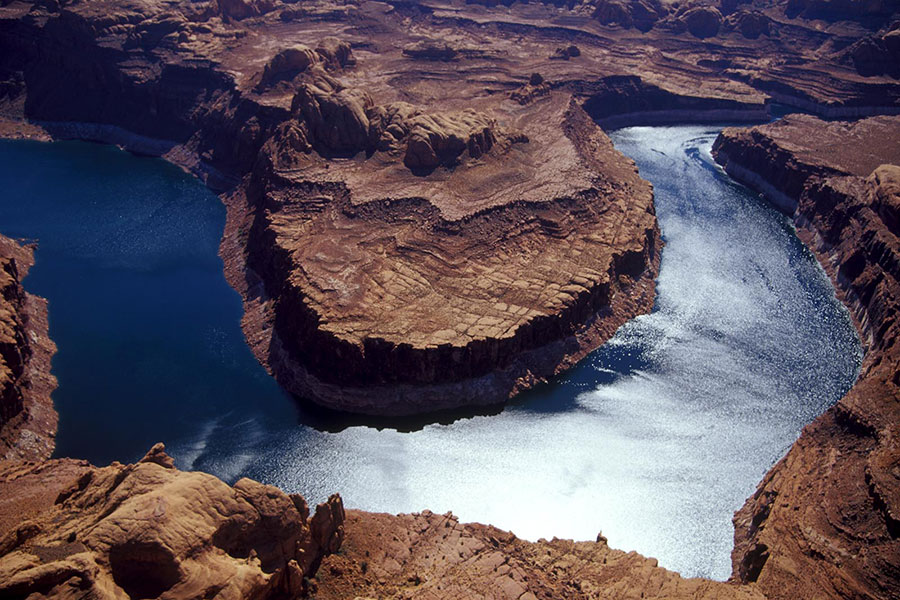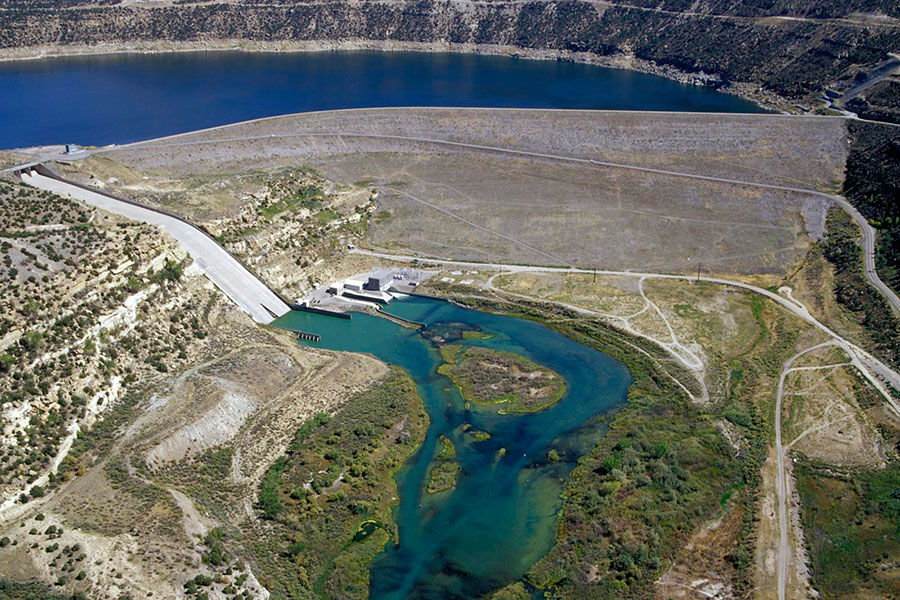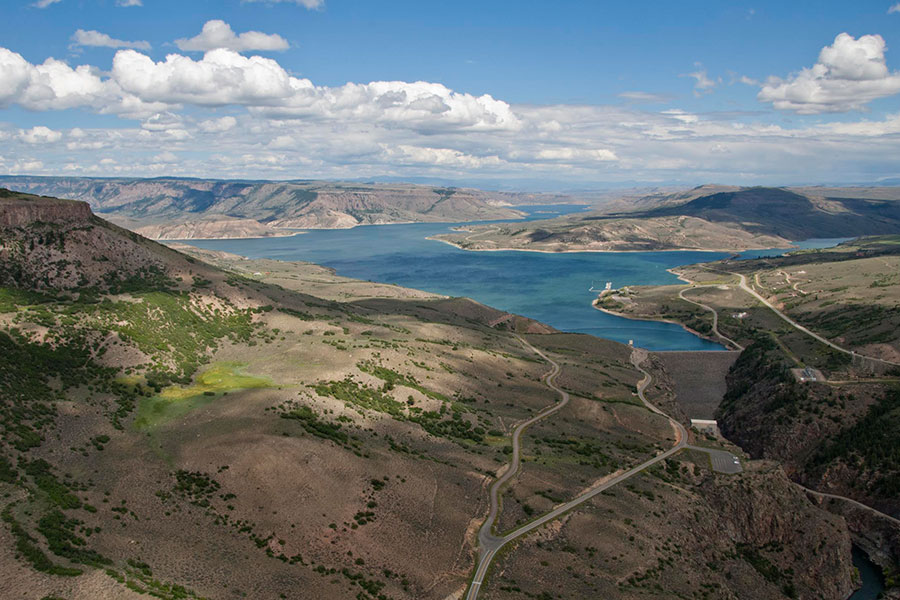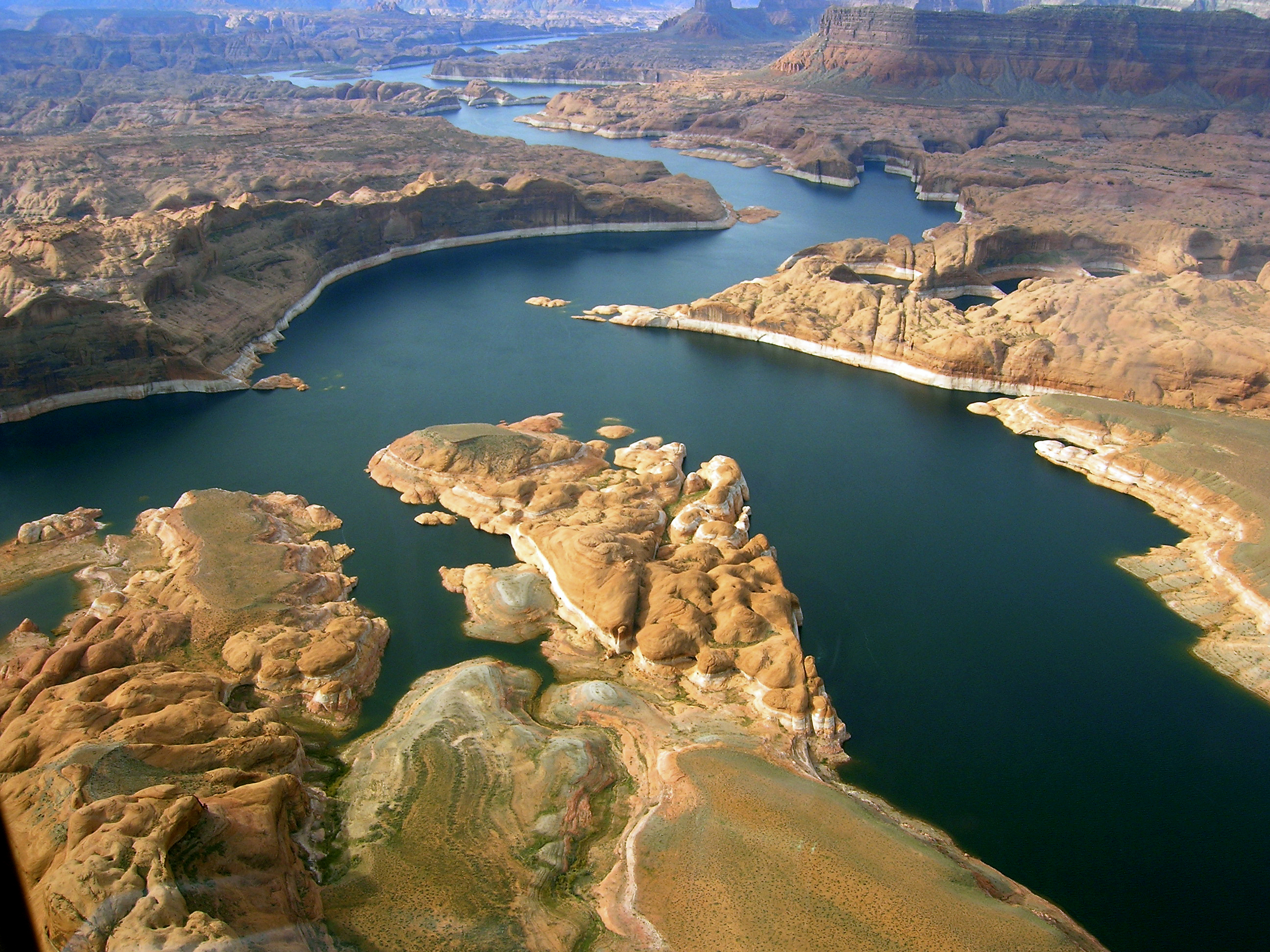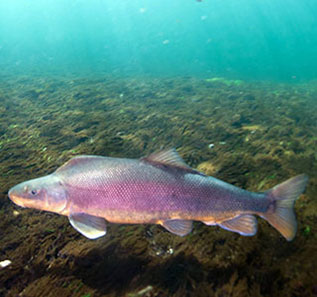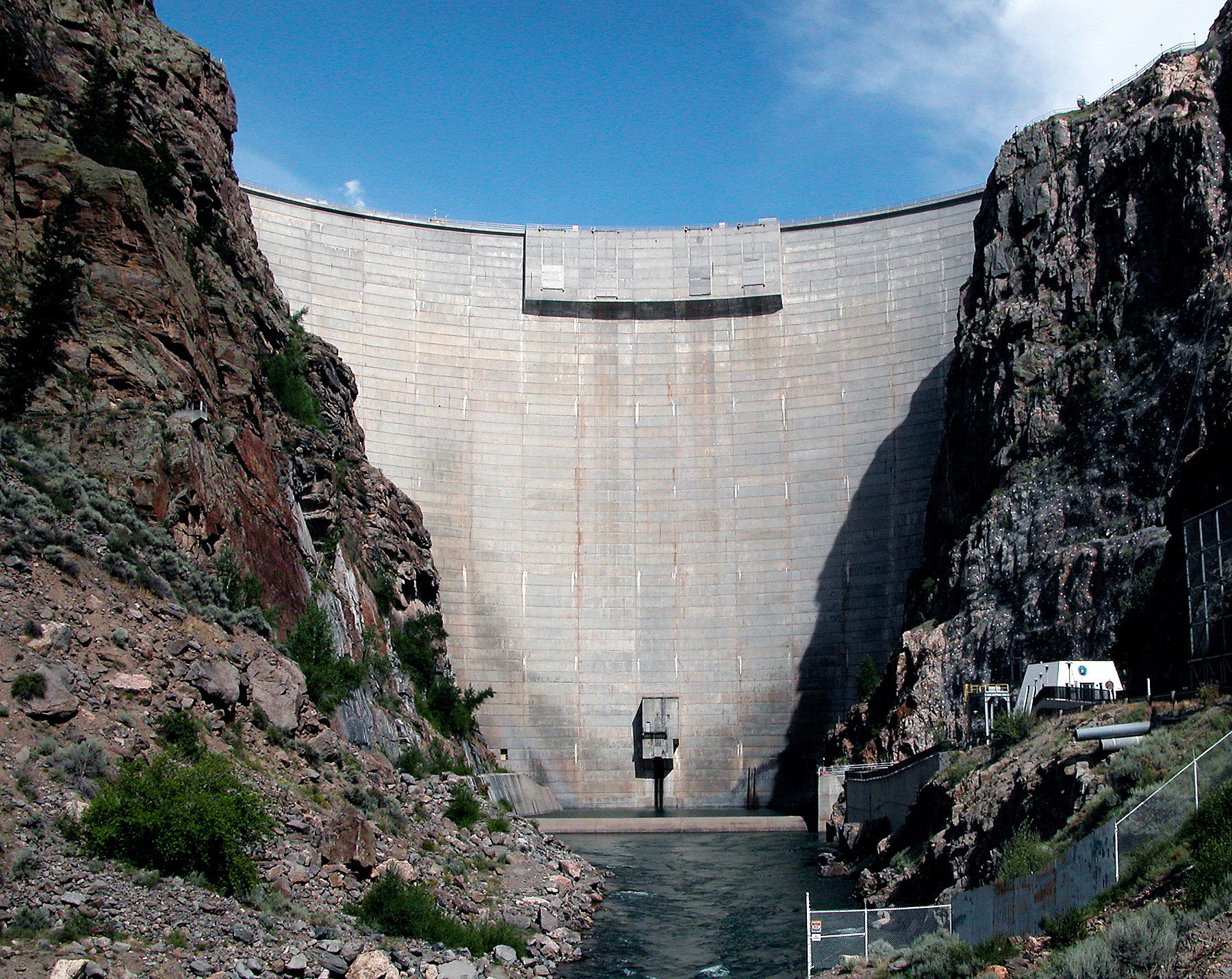- Reclamation
- Upper Colorado Basin
- Colorado River Storage Project
Colorado River Storage Project
- Overview
- Basin Fund
- Benefits
- History
- Hydropower
- Law of the River
- Participating Projects
- Water Operations
- Water Quality
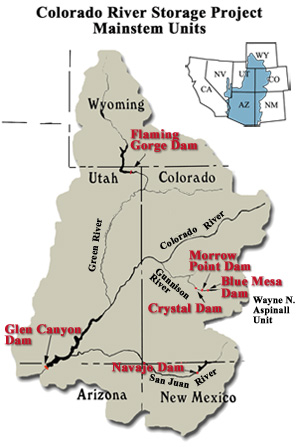
The 1956 Colorado River Storage Project Act has had a significant impact on the development and management of water in the Upper Colorado River Basin. The 1956 act authorized construction of the Colorado River Storage Project (CRSP) which allowed for comprehensive development of the water resources of the Upper Basin states (Colorado, New Mexico, Utah, and Wyoming) by providing for long-term regulatory storage of water for purposes including, regulating the Colorado River, storing water for beneficial use, allowing Upper Basin States to utilize their Colorado River Compact apportionments, providing for the reclamation of arid lands, control of floods and generation of hydroelectric power. The Colorado River Storage Project is one of the most complex and extensive river resource developments in the world.
There are four initial storage units built as part of the CRSP:
- Wayne N. Aspinall Unit in Colorado (Blue Mesa, Crystal, and Morrow Point Dams),
- Flaming Gorge Unit in Utah,
- Navajo Unit in New Mexico,
- Glen Canyon Unit in Arizona;
During the 1960's and 1970's, public concern over the environment resulted in new federal environmental laws. The enactment of the 1969 National Environmental Policy Act, the 1973 Endangered Species Act, and the 1992 Grand Canyon Protection Act outlined new requirements for the protection and enhancement of fish, wildlife, and the environment. Administration of these laws has modified the operation of CRSP facilities.
The dams of the CRSP main storage units have a combined live storage capacity of 30.6 million acre-feet and power generation capabilities to provide over five billion kilowatt-hours of energy annually. Glen Canyon Dam is the largest of the CRSP facilities and is the key unit for controlling water releases to the Lower Basin. In 1970, the Criteria for Coordinated Long-Range Operation of Colorado River Reservoirs (Operating Criteria) was established to provide for the coordinated operation of reservoirs in the Upper and Lower basins and set conditions for water releases from Lake Powell and Lake Mead. In accordance with the Operating Criteria, an objective release of 8.23 million acre-feet per year is targeted for downstream delivery.
The multipurpose CRSP has not only been integral to the development of the arid West, it has also played a vital sustaining role through extended periods of drought. The many benefits provided by the CRSP are essential to life in the West today.
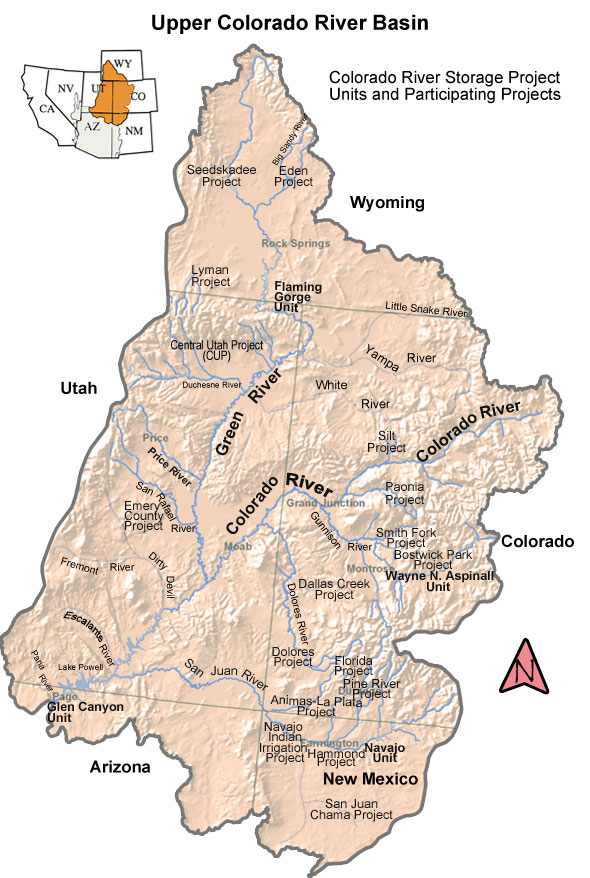 The Upper Colorado River Basin Fund (Basin Fund) was established under Section 5 of the CRSP Act. The CRSP Act 'authorized a separate fund in the Treasury of the United States to be known as the Upper Colorado River Basin Fund... for carrying out provisions of this Act other than Section 8'. Money appropriated for construction of CRSP facilities, except recreation and fish and wildlife facilities constructed under Section 8, is transferred to the Basin Fund from the General Fund of the Treasury. Revenues derived from operation of the CRSP and participating projects are deposited in the Basin Fund. Most of the revenues come from sales of hydroelectric power and transmission services. The Basin Fund also receives revenues from M&I water service sales, rents, salinity funds from the Lower Colorado Basin (as a pass-through for the Colorado River Basin Salinity Control Program), and miscellaneous revenues collected in connection with the operation of the CRSP and participating projects. Revenues and appropriated funds are accounted for separately in the Basin Fund.
The Upper Colorado River Basin Fund (Basin Fund) was established under Section 5 of the CRSP Act. The CRSP Act 'authorized a separate fund in the Treasury of the United States to be known as the Upper Colorado River Basin Fund... for carrying out provisions of this Act other than Section 8'. Money appropriated for construction of CRSP facilities, except recreation and fish and wildlife facilities constructed under Section 8, is transferred to the Basin Fund from the General Fund of the Treasury. Revenues derived from operation of the CRSP and participating projects are deposited in the Basin Fund. Most of the revenues come from sales of hydroelectric power and transmission services. The Basin Fund also receives revenues from M&I water service sales, rents, salinity funds from the Lower Colorado Basin (as a pass-through for the Colorado River Basin Salinity Control Program), and miscellaneous revenues collected in connection with the operation of the CRSP and participating projects. Revenues and appropriated funds are accounted for separately in the Basin Fund.
Basin Fund revenues must first be used to repay costs associated with the operation, maintenance, and replacements of, and emergency expenditures for, the CRSP initial units. The fund is then used to repay the United States Treasury Department for the following:
- The construction costs of the CRSP initial units allocated to the power purpose (with interest thereon)
- The construction costs of the CRSP initial units allocated to irrigation
- A portion of salinity investment and operation costs
- The construction costs of the participating projects allocated to the irrigation investment and above the irrigator's ability to pay
The Basin Fund also supports the following:
- Cost sharing for Colorado River Basin Salinity Control Program (approximately $2.0 million annually)
- The major portion of the cost of the Glen Canyon Adaptive Management Program (currently almost $9.5 million annually)
- Cost sharing for the Upper Colorado and San Juan Endangered Fish Recovery Implementation Programs (currently approximately $7 million annually)
- Water quality studies
- Consumptive use studies
The approximately $16.5 million per year of power revenues expended for the Glen Canyon Adaptive Management Program, the Upper Colorado River Recovery Implementation Program, and the San Juan Basin Recovery Program are expenses that are not built into the firm power rates. This arrangement benefits the programs in that they do not need to seek annual appropriations from Congress for these funds. However, this does have an impact to Western in times when firming power purchase expenses are high (due to drought or experimentation) because the moneys are transferred to the program and are not available to purchase the power needed to meet contractual requirements. The Basin Fund is managed by Western. Approximately $120 million in revenue is needed each year to fund Reclamation and Western operation and maintenance needs. Western is responsible for transmission and marketing of CRSP power, collecting payment for the power, and transfer of revenues for repayment to the United States Treasury Department. A change in the amount of available capacity or energy could potentially affect the revenue derived from the sale of energy and the contributions to the Basin Fund, or rates charged to power customers.
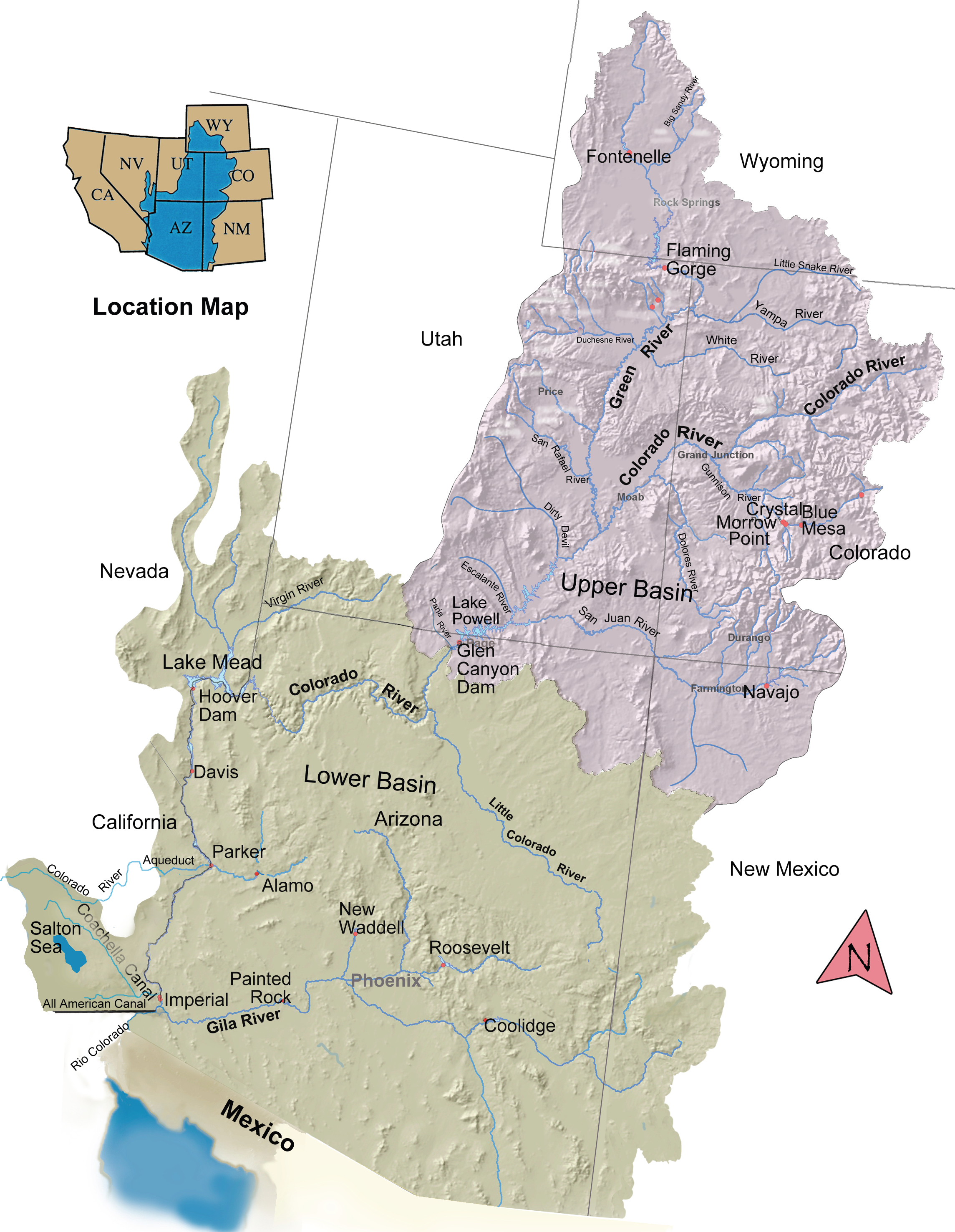 There are many benefits associated with the multi-purpose Colorado River Storage Project.
There are many benefits associated with the multi-purpose Colorado River Storage Project.
- The Colorado River Storage Project (CRSP) has been integral to the development of the arid West by providing water and hydropower for sustained growth and enhanced quality of life
- Today, the water storage and other benefits of the CRSP contribute significantly to the needs of the growing population of the West.
- The 1956 Act authorizing the CRSP, represents a key piece of the overall Colorado River management structure outlined by Law of the River.
- The CRSP primary units and participating projects conserve the very limited precipitation which falls primarily in the form of snow in the high mountains for municipal, industrial, agricultural, and other beneficial use.
- CRSP storage is allowing the Upper Colorado River Basin to develop its apportionments of the Colorado River while assuring the required water delivery to the Lower Colorado River Basin as defined in the 1922 Colorado River Compact.
- The CRSP provides long-term carry-over storage that has a leveling effect on the erratic Colorado flows varying from four to 22 million acre-feet annually.
- The dams associated with the CRSP initial units (Glen Canyon, Flaming Gorge, Blue Mesa, Morrow Point, Crystal, Navajo) have a total combined live storage capacity of 30.6 million acre-feet, providing for the water needs of millions of people in the seven Colorado River Basin states.
- Glen Canyon Dam and Lake Powell, the key feature of the CRSP, function like a bank account of water that is drawn upon in times of drought. Without it, during drought periods, the Upper Basin states would realize additional shortages in order to meet Lower Basin delivery obligations.
- The CRSP is a key factor in finding solutions to increasing demands for limited water supplies.
- The CRSP system is adaptively managed with an eye toward changing public values and greater societal awareness about the importance of healthy ecosystems.
- Hydropower provided by CRSP facilities contributed to the modernization and urbanization of the West.
- CRSP hydropower facilities provide enough clean, renewable hydroelectric energy to assist in serving the needs of approximately 5.8 million customers in seven Western states. CRSP facilities have the capability to generate over four billion kilowatt-hours of energy annually.
- Revenues collected from hydropower generation at CRSP facilities are credited to the Upper Colorado River Basin Fund and used for several beneficial purposes including:
- Repayment of the initial construction costs of the project
- Help repay the construction costs of the participating projects allocated to irrigation, that are beyond the irrigators' ability to pay
- Pays for operation and maintenance of initial units
- Pays for several important environmental programs such as the Upper Colorado River Endangered Fish Recovery Program and the Glen Canyon Dam Adaptive Management Program
- Pays a portion of salinity control projects
- Purchases additional power to meet contractual obligations when CRSP power supplies are insufficient
- CRSP facilities provide for a host of scenic and recreational opportunities that have significant economic benefits.
- Recreation use at CRSP initial facilities totaled over four million visitor days in FY2005/2006, demonstrating the high value placed on outdoor recreation opportunities in the West.
- Two CRSP reservoir areas were officially designated as national recreation areas by Congress to preserve the recreation value for the public: Glen Canyon National Recreation Area and Flaming Gorge National Recreation Area. The area surrounding the Aspinall Unit reservoirs is called the Curecanti National Recreation Area although it has not officially been designated as such by Congress.
- Tribal lands have benefited by the construction of the Navajo Indian Irrigation Project, a CRSP participating project, which consists of a network of irrigation facilities that draw water from Navajo Dam and Reservoir (a CRSP initial unit) to serve the Navajo Reservation in northeastern Arizona.
Life as we know it today in the western United States would be very different without the reality and benefits of the Colorado River Storage Project (CRSP). This multipurpose project provides many benefits and sustains life and economic well-being in the West. Although the CRSP didn't become a reality until the authorizing legislation was signed in 1956, the need for the CRSP clearly emerged as the complexities of water development and management began to unfold throughout the 20th century.
The scarcity of water and the challenges of making this vital resource available to support development and growth have always been at the heart of the West's history. In the Colorado River Basin, the waters of the Colorado River have long been the source of intense debate and negotiation, resulting in a century of federal laws, compacts, court decisions and decrees, treaties, and regulatory guidelines known collectively as the Law of the River. Thus, the Colorado River is considered the most regulated river in the world today.
The Law of the River originated with the Colorado River Compact of 1922, which is considered the cornerstone of the Law of the River. The need for this foundation document grew out of early contention over the Colorado River. By the early 1900's, California was rapidly growing and the Imperial Valley in California was already relying heavily on the Colorado River for significant agricultural development. The burgeoning growth of California caused concern for the other Colorado River Basin states for fear that California would establish priority rights to Colorado River water. Because Western water law was based on the doctrine of "prior appropriation" (first in time, first in right) giving highest priority to first users of water, it was entirely possible that a fast growing state like California could establish priority rights before the rest of the basin states could develop what they viewed as their fair share of the river.
In order to resolve this pivotal issue, discussions for an interstate compact between the Colorado River Basin states began in January 1922 to determine how to equitably divide and apportion the use of the Colorado River's water among the seven Colorado River Basin states. After nearly a year of negotiations, the provisions of the Colorado River Compact were agreed upon by each of the seven Colorado River Basin states. The compact divided the river system into two sections; the Upper Basin (comprised of Colorado, New Mexico, Utah, and Wyoming and a portion of Arizona) and the Lower Basin (comprised of California, Nevada, and Arizona) with the dividing point at Lee Ferry, Arizona, and established that each basin would receive 7.5 million acre-feet of water annually. It also gave priority to delivery of the Lower Basin's entitlement requiring the Upper Basin to ensure delivery of 75 million acre-feet to the Lower Basin in any rolling 10-year period regardless of hydrology. Because the flow of the Colorado River is erratic with flows varying from four to 22 million acre-feet annually, this left the Upper Basin to deal with the challenges of uncertain river flows.
Because the issues and interests associated with the Colorado River are complex and extensive, the 1922 compact was only the first of many legal documents to govern the use of the Colorado River. Other important Law of the River documents came about after the 1922 Colorado River Compact that further clarified rights, authorities, obligations, and priorities, and authorized construction of many water development projects. By the early 1950's, many federal water projects were in place in the Lower Basin, including Hoover Dam, Laguna Dam, Imperial Dam, Parker Dam, Davis Dam, and the All-American Canal. The Upper Basin states, fearing that efforts would be made by the Lower Basin states to claim additional water, initiated development of their water to sustain future growth. This concern, coupled with the undependable nature of Colorado River flows and the Upper Basin's delivery obligations to the Lower Basin, led to the planning of the multi-purpose Colorado River Storage Project.
The need for the Colorado River Storage Project was actually envisioned at the time of the Colorado River Compact, and it was made possible by the groundwork laid by the 1922 Compact. With the Upper and Lower Basin distinction established and each basin's allocation of the Colorado River identified, the Compact set the stage for the development that would be authorized by additional Law of the River legislation, including the CRSP Act.
Authorized by Congress on April 11, 1956, the Colorado River Storage Project Act became an important force in the development and management of water in the Upper Basin. The CRSP was intended to provide water storage in the Upper Basin to allow the Upper Basin to develop its apportionments of the Colorado River while assuring the required water delivery to the Lower Basin. This would be accomplished through construction of four initial storage units: the Wayne N. Aspinall Unit in Colorado (Blue Mesa, Crystal, and Morrow Point Dams), Flaming Gorge Unit in Utah, Navajo Unit in New Mexico, and Glen Canyon Unit in Arizona. The CRSP Act also authorized a number of participating projects to deliver irrigation water to farms and provide municipal and industrial water to many communities.
The CRSP initial stoarage units and participating projects store the limited precipitation which falls principally in the form of snow in the high mountains of the Upper Basin for municipal, industrial, and agricultural use. In addition, the CRSP provides other valuable benefits including flood control, recreation, and hydropower generation which have significant economic impact in the West. The CRSP initial storage units have a combined live storage capacity of 30.6 million acre-feet and power generation capabilities to provide over four billion kilowatt-hours of energy annually.
It has been over 50 years since the Congress authorized the Colorado River Storage Project. Since that time, the foresight of the framers of the CRSP has been demonstrated as the purposes for which the CRSP was built continue to be realized. The importance of the purposes and benefits provided by the CRSP cannot be overstated, particularly in light of the extended periods of drought that have been weathered successfully. Water deliveries to the Lower Basin and Mexico have consistently been made without creating significant shortages in the Upper Basin because of the long-term regulatory storage provided by Glen Canyon Dam and Lake Powell, the principal feature of the CRSP.
As the population of the West continues to grow, so will the challenges and complexities of western water management. The Colorado River Storage Project has been integral to the development of the arid West, and it will continue to play a vital role in the future of the West. Finding solutions to increasing demands for limited water supplies while providing other important benefits would be more difficult without the CRSP.
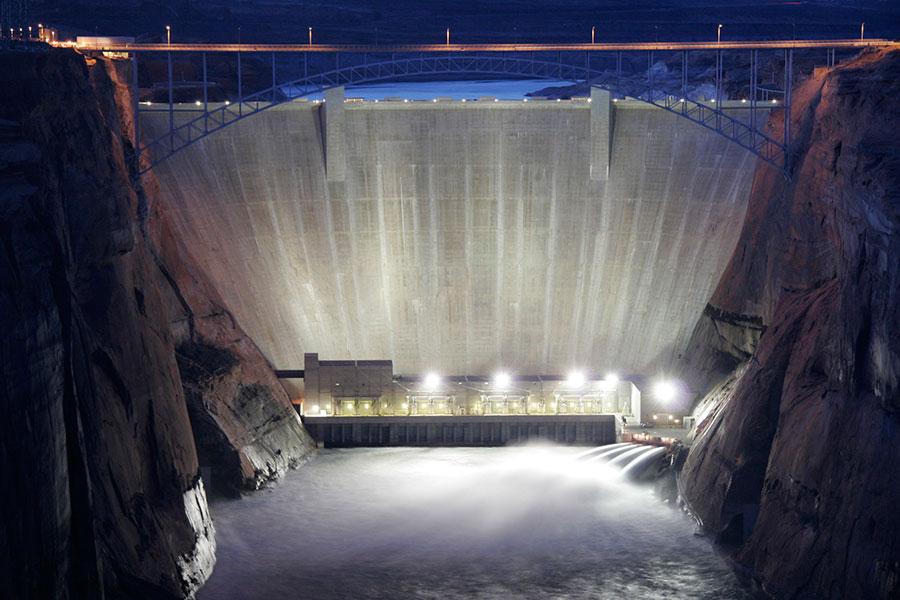
 The Colorado River Storage Project (CRSP) Act, passed on April 11, 1956, authorized construction of four initial units and the first 11 participating projects, to regulate the flow of the Colorado River. These units provide water storage for beneficial consumptive use, reclamation of arid and semi-arid land, control floods and generate hydroelectric power.
The Colorado River Storage Project (CRSP) Act, passed on April 11, 1956, authorized construction of four initial units and the first 11 participating projects, to regulate the flow of the Colorado River. These units provide water storage for beneficial consumptive use, reclamation of arid and semi-arid land, control floods and generate hydroelectric power.
Three of the four initial CRSP units?Glen Canyon Unit, Flaming Gorge Unit, and the Wayne N. Aspinall Unit?include hydropower plants. Reclamation generates power at these facilities by harnessing the kinetic energy of flowing water as it moves downstream and converting it to electricity?resulting in enough clean, renewable hydroelectric energy to assist in serving the needs of nearly 5.8 million customers in seven Western states. The CRSP facilities alone have the capability to generate over 5 million MW*hrs of energy annually.
Energy generated at CRSP power plants that is surplus to Reclamation's project needs, is sold to serve the electrical demand of customers in the states of Arizona, Colorado, Nebraska, New Mexico, Utah and Wyoming. Reclamation, through its marketing partner, the Western Area Power Administration (Western), offers low priced CRSP energy to cooperatives, municipalities, publically owned utilities, state and federal agencies, or tribes that meet specific criteria to be considered preference customers. These preference customers are typically in disadvantaged markets due to their location or dispersed population bases. For-profit utilities typically have little incentive to invest in the infrastructure necessary to service these customers. Reclamation, through Western, offers this energy at rates that are based on Reclamation's production costs (cost-based), which are very low in comparison to electrical resources available on the open market. By Reclamation supplying this low priced CRSP surplus energy to preference customers, the economies of these rural areas of the Southwest have benefitted greatly. For example, the wholesale composite rate for CRSP energy has ranged from $20.17/MW to $29.62/MW over the past two decades. For comparison purposes, the average wholesale market price between 2001 and 2013 at the Palo Verde Hub was about $49/MW.
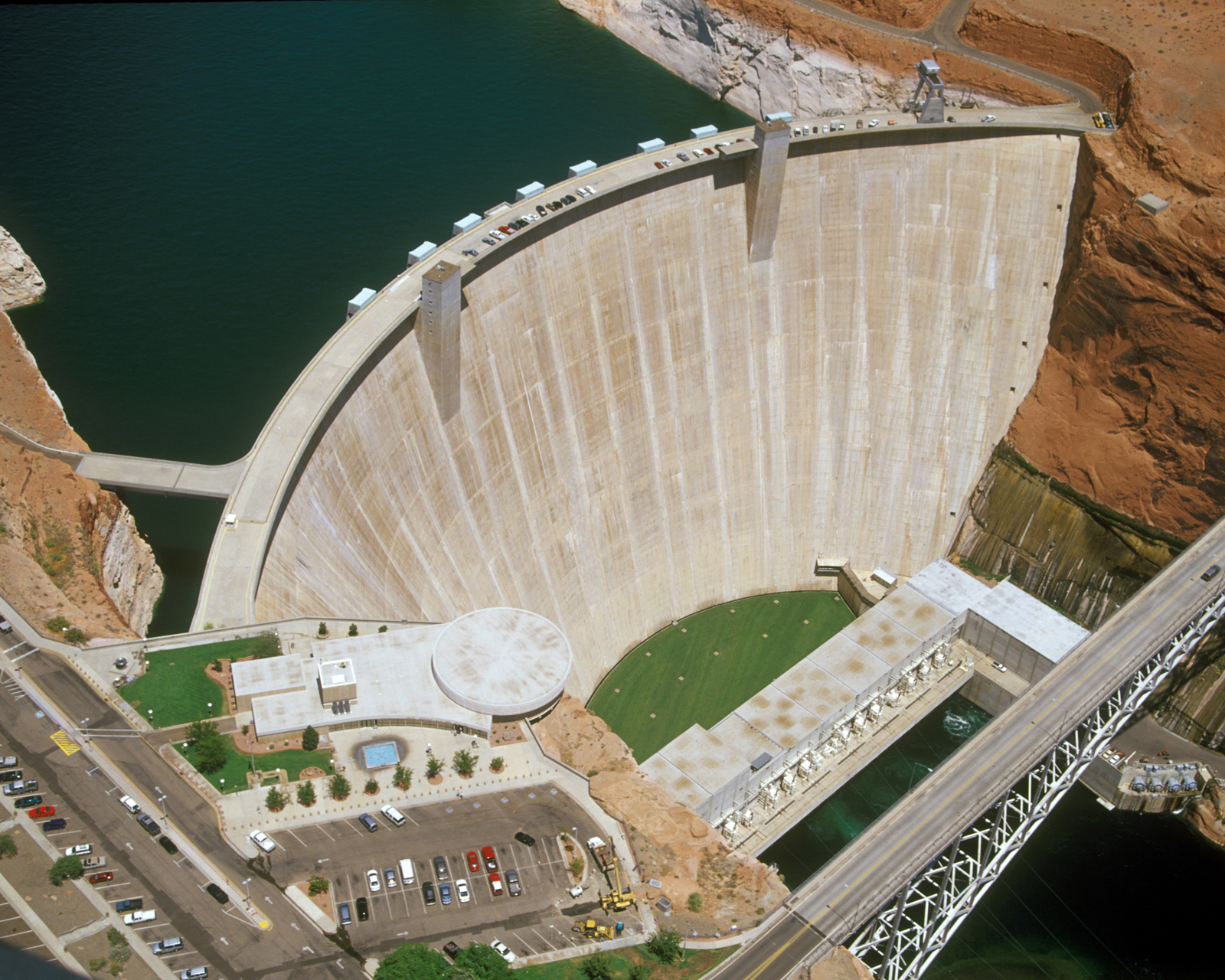
Revenue generated from the sale of surplus energy is used by Reclamation to repay the U.S. Treasury for the initial construction costs of CRSP facilities. To date, nearly $600 million in power revenue has returned to the Treasury, leaving less than $233 million to be repaid.
Power revenue also funds the continued operation and maintenance of CRSP dams and power plants. For example, over the past 10 years, Reclamation has replaced the eight turbine runners at Glen Canyon Dam with new high efficiency turbine runners, resulting in more efficient and reliable power generation at no additional cost to the American taxpayer. This enables Reclamation to continually update and improve power generating equipment.
Reclamation and Hydropower
Soon after the Reclamation Service came into being, the potential for, and benefit of, hydroelectric power generation at Reclamation facilities was recognized and the agency's responsibility was expanded to include hydropower production.
Today, Reclamation is the second largest producer of hydropower in the country, operating 58 hydroelectric power plants that generate over 42 million megawatt hours (MW*hr) of energy per year. To put it into perspective, that's enough energy to meet the annual residential needs of 14 million people and is the energy equivalent of over 80 million barrels of crude oil.
Reclamation's Upper Colorado Region operates nine of those 58 power plants in Arizona, Colorado, New Mexico, Utah and Wyoming, producing over 5 million MW*hr of energy per year. Throughout the 20th century, the hydroelectric power generated by Reclamation facilities helped stimulate tremendous growth and opportunity across the West. The clean, inexpensive electrical energy provided by these hydropower facilities has become increasingly more influential in determining the function, benefits, impacts and scale of Reclamation's projects. Capturing the energy produced by falling water and converting it to electricity provides the necessary power for domestic and industrial users, while generating revenues that helped finance larger irrigation projects as part of the comprehensive river basin development. One such comprehensive river basin development is the Colorado River Storage Project.
Related Resources
Benefits of Hydropower
Hydropower Generation Basic
Other Links
Power Area Office
Reclamation's Hydropower Program
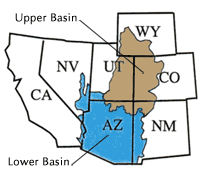 Law of the River Documents
Law of the River Documents
Colorado River Compact of 1922 - The foundational agreement governing the Colorado River. Apportions Colorado River water in "perpetuity" between the Upper and Lower Basins.
Boulder Canyon Project Act of 1928 - This act provided for the necessary Congressional approval of the Colorado River Compact of 1922. Authorized the construction of Hoover Dam and other water storage and delivery facilities in the Lower Basin. Created a comprehensive apportionment among California (4.4 maf), Arizona (2.8 maf), and Nevada (0.3 maf) of the Lower Basin's share of the mainstream waters of the Colorado River.
California Seven Party Agreement of 1931 - This agreement helped settle the long-standing conflict between California agricultural and municipal interests over Colorado River water priorities. The seven principal claimants reached consensus in the amounts of water to be allocated on an annual basis to each entity.
Mexican Water Treaty of 1944 - Allots to Mexico, a guaranteed annual quantity of 1.5 million acre feet of the waters of the Colorado River. It also provides for additional or lesser deliveries in identified circumstances.
Upper Colorado River Basin Compact of 1948 - Apportions the Upper Basin's allocation of Colorado River water among Colorado, New Mexico, Utah, Wyoming, and the portion of Arizona that lies within the Upper Colorado River Basin
Colorado River Storage Project Act of 1956 - Provides a comprehensive water resource development plan for the Upper Basin and authorized the construction of Glen Canyon, Flaming Gorge, Navajo and Curecanti dams as well as other participating projects, for multiple purposes.
Arizona v. California 1964 - Supreme Court's original decree issued in Arizona v. California. This decree addresses allocation of Colorado River water and establishes limits on the United States operation of certain Colorado River reservoirs. The decree has been updated and amended on numerous occasions since 1964. The Supreme Court entered a Consolidated Decree in 2006 which incorporates all applicable provisions of the earlier issued decrees.
Colorado River Basin Project Act of 1968 - This act authorized construction of a number of water development projects in both the upper and lower Colorado River basins, including the Central Arizona Project (CAP). It also made the priority of the CAP water supply subordinate to California's apportionment in times of shortage, and directed the Secretary to prepare, among other things, long-range operating criteria for the Colorado River reservoir system in consultation with the Colorado River Basin states.
The Criteria for Coordinated Long-Range Operation of Colorado River Reservoirs of 1970 (amended March 21, 2005) - Addresses the coordinated long-range operation of Colorado River reservoirs in the upper and lower basins pursuant to the Colorado River Basin Project Act of 1968.
Minute 242 of the U.S. - Mexico International Boundary and Water Commission of 1973 - Addresses actions to reduce the salinity of water being delivered to Mexico at Morelos Dam.
Colorado River Basin Salinity Control Act of 1974 - Authorized desalting and salinity control projects, including the Yuma Desalting Plant, to improving Colorado River quality.
Grand Canyon Protection Act of 1992 - Addresses the protection of resources in Grand Canyon National Park and in Glen Canyon National Recreation Area, consistent with and subject to applicable provisions of federal law.
Related Legislation
Endangered Species Act of 1973 - Provided for the conservation of ecosystems upon which threatened and endangered species of fish, wildlife, and plants depend.
National Environmental Policy Act of 1969 - Established a national policy to promote the enhancement of the environment including the requirement that environmental impact statements be developed for major U.S. federal government actions. Also established the President's Council on Environmental Quality (CEQ).
National Historic Preservation Act of 1966 - Intended to preserve historical and archaeological sites in the United States of America. The act created the National Register of Historic Places, the list of National Historic Landmarks, and the State Historic Preservation Offices.
The Colorado River Storage Project was authorized by Congress with the passage of the CRSP Act of 1956. The CRSP Act authorized construction of the initial units (Curecanti [later renamed the Aspinall Unit], Flaming Gorge, Navajo, and Glen Canyon) and participating projects. Colorado River operations, including CRSP operations, are governed by a complex set of authorities referred to as the 'Law of the River.'
Annual Operating Plans
Each year the Secretary of the Interior prepares an annual operating plan describing among other things, the projected operations for Colorado River reservoirs for the upcoming year.
24-Month Studies
The 24-Month Study is the operational study that uses forecasted inflows and expected operations to project future Colorado River reservoir volumes and releases for the next 24-month period. Reclamation updates the projections each month using the previous month's reservoir volumes and the latest inflow forecasts and water use forecasts. The updated results of the 24-Month Study model run are published in the 24-Month Study report which is issued monthly.
Forums for Information Exchange
Working groups for the Aspinall Unit, Flaming Gorge Reservoir, Fontenelle Reservoir, and Navajo Reservoir meet two to three times annually to discuss past, current, and proposed reservoir operations. These meetings, led by either the Provo Area Office or the Western Colorado Area Office, are open to the public and participants are encouraged to comment. Operational decisions are not made during the working group meetings; rather the meetings provide a forum for information exchange. At these meetings, stakeholders can also share information about specific resources of interest and the relationship between reservoir operations and these resources. The working groups provide input to Reclamation as well as educate various constituencies on operations of the reservoirs.
Working Group Information
Aspinall Working Group
Flaming Gorge Working Group
Flaming Gorge Technical Working Group
Fontenelle Working Group
Navajo Dam Technical Working Group
Glen Canyon Dam Adaptive Management Program
The Water Resources Group, Upper Colorado Region, then projects water release schedules for all CRSP facilities and coordinates with the Western Area Power Administration.
Current Status
The current status of each CRSP reservoir provides information about current reservoir conditions and operations as well as basin hydrology and water supply forecasts.
Reservoir Data
CRSP reservoir storage, inflow, releases, elevation data & more.
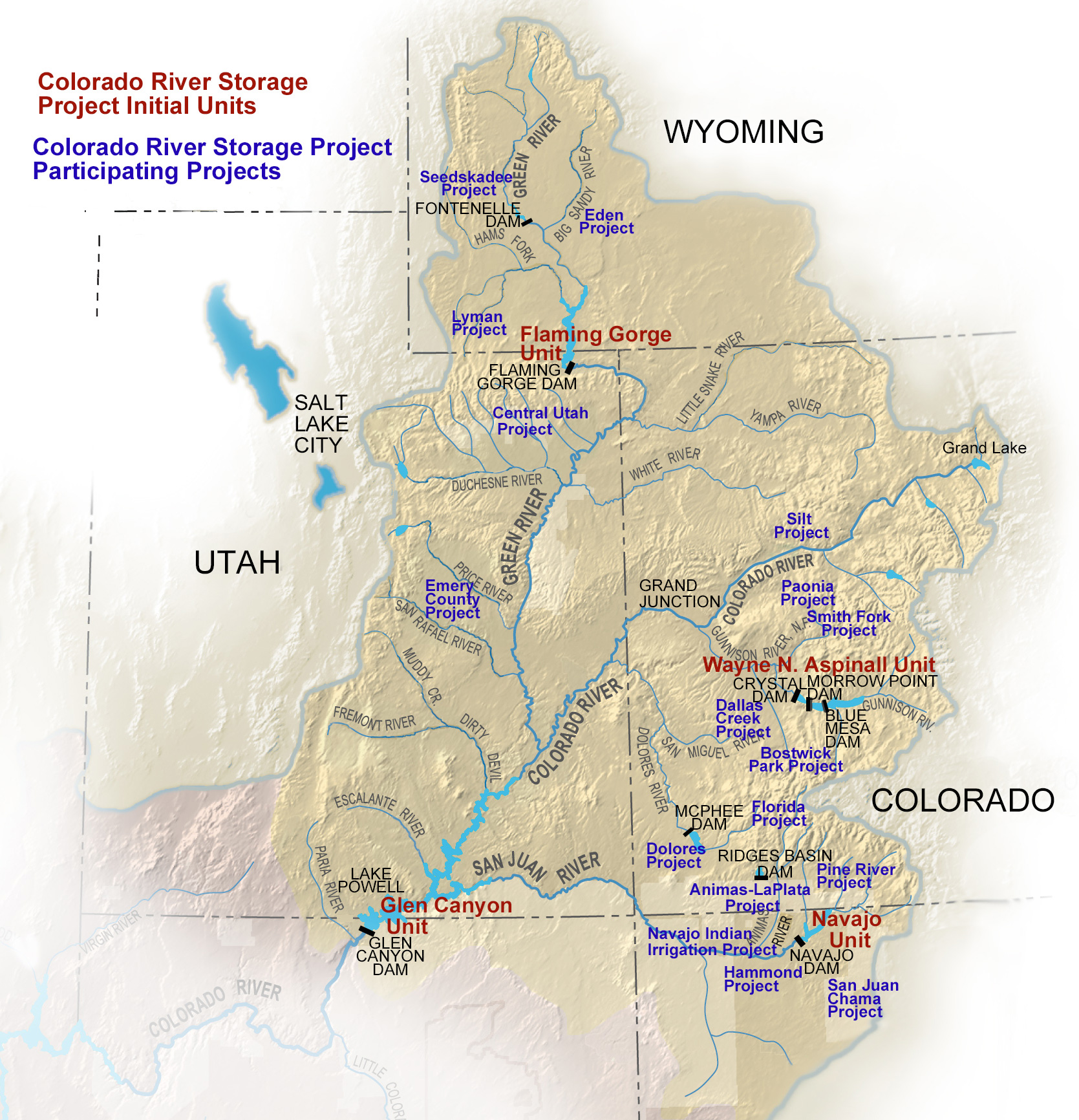 The Colorado River Storage Project Act, authorized on April 11, 1956, became an important factor in the development and management of water in the Upper Basin. The act authorized construction of the Colorado Storage Project (CRSP) which was intended to provide for storage in the Upper Basin to allow the Upper Basin to develop its apportionment of the Colorado River while assuring delivery of the Lower Basin's full allocation.
The Colorado River Storage Project Act, authorized on April 11, 1956, became an important factor in the development and management of water in the Upper Basin. The act authorized construction of the Colorado Storage Project (CRSP) which was intended to provide for storage in the Upper Basin to allow the Upper Basin to develop its apportionment of the Colorado River while assuring delivery of the Lower Basin's full allocation.
The CRSP Act authorized construction of four initial units which included: the Wayne N. Aspinall Unit in Colorado (Blue Mesa, Crystal, and Morrow Point Dams), Flaming Gorge Unit in Utah, Navajo Unit in New Mexico, and Glen Canyon Unit in Arizona; and the construction of 11 participating projects. Subsequent legislation expanded the total number of authorized participating projects to 23 although one project was deleted. There are currently 22 authorized participating projects.
The purpose of the participating projects was to develop water in the Upper Colorado River system for irrigation, municipal and industrial uses, and other purposes, and participate in the use of revenues from the Upper Colorado River Basin Fund to help repay the costs of irrigation features that are beyond the ability of the water users to repay. Revenues from hydropower developed at the CRSP initial units were used to fund these smaller irrigation projects which supply water to agricultural and urban areas outside the watershed.
To date, 16 of the currently authorized 22 projects have been completed or are in the process of completion. The five remaining participating projects were determined to be infeasible and were not built. The participating projects supply more than 554,000 acre-feet of water for irrigation with an annual gross crop value of more than $49 million. These projects also provide more than 110 billion gallons of water annually to meet all or part of the needs of more than 1.2 million people.
Originally authorized Participating Projects:
- Central Utah (initial phase) - Utah
- Emery County - Utah
- Florida - Colorado
- Hammond - New Mexico
- La Barge - Wyoming ***Later found to be infeasible***
- Lyman - Wyoming and Utah
- Paonia - Colorado (works additional to existing project)
- Pine River (Extension) _ Colorado and New Mexico **Deleted**
- Seedskadee - Wyoming
- Silt - Colorado
- Smith Fork - Colorado
Participating Projects Authorized by Subsequent Legislation:
- Eden - Wyoming
- San Juan-Chama - Colorado & New Mexico
- Navajo Indian Irrigation Project - New Mexico
- Bostwick Park - Colorado
- Fruitland Mesa - Colorado **Later found to be infeasible**
- Savery-Pot Hook - Colorado and Wyoming **Later found to be infeasible**
- Animas-La Plata - Colorado
- Dallas Creek - Colorado
- Dolores - Colorado
- San Miguel - Colorado **Later found to be infeasible**
- West Divide - Colorado **Later found to be infeasible**
- Navajo-Gallup Water Supply Project
Water quality in the Colorado River affects all beneficiaries of the water from the aquatic ecosystem to municipal, industrial, and agricultural users to recreationists. The Colorado River Storage Project (CRSP) reservoirs have a large influence on water quality in the Colorado River. Reclamation directs and participates in studies to monitor and improve water quality in the Colorado River Basin.
One of the long recognized water quality concerns of the Colorado River is salinity, which affects agricultural, municipal, and industrial use in both the United States and Mexico. Congress has enacted several Acts related to investigating, monitoring, and implementing measures to deal with the salinity concerns of the Colorado River...More →
In addition to salinity, other water quality constituents are monitored on the Colorado River and its tributaries and in the storage reservoirs. A network of 20 stream gages and field sampling activities are funded in full or in part by Reclamation. In the CRSP reservoirs, water quality constituents are monitored through regular sampling programs. At Lake Powell, for example, water quality monitoring is funded by Reclamation and performed by the USGS in cooperation with Reclamation and the National Park Service. Monitoring is conducted monthly for samples above and below the dam and quarterly for lake-wide samples. This monitoring provides valuable information for programs such as the Glen Canyon Dam Adaptive Management Program.
The activities relating to water quality are summarized in the report from the Secretary of the Interior to Congress and the states of the Colorado River Basin known as the 'Quality of Water Colorado River Basin Progress Report', which has been issued every two years since 1963. The most recent report is Progress Report 22.
